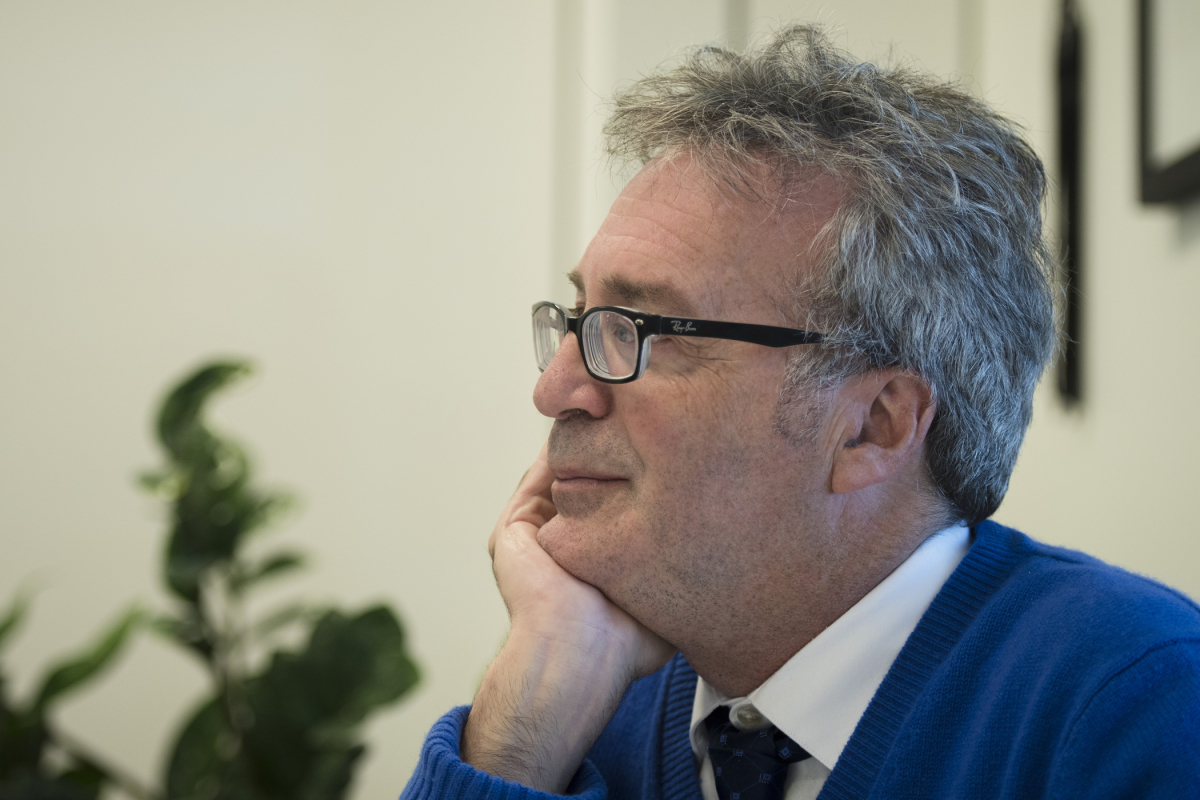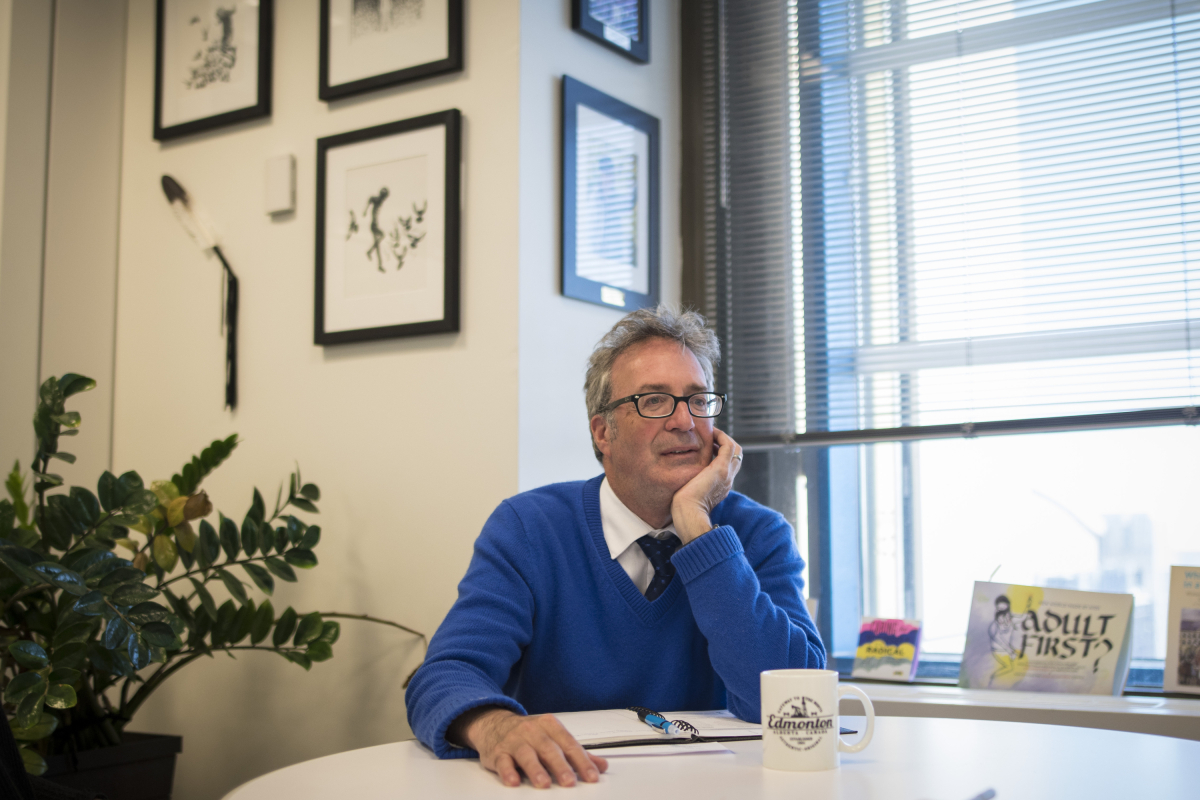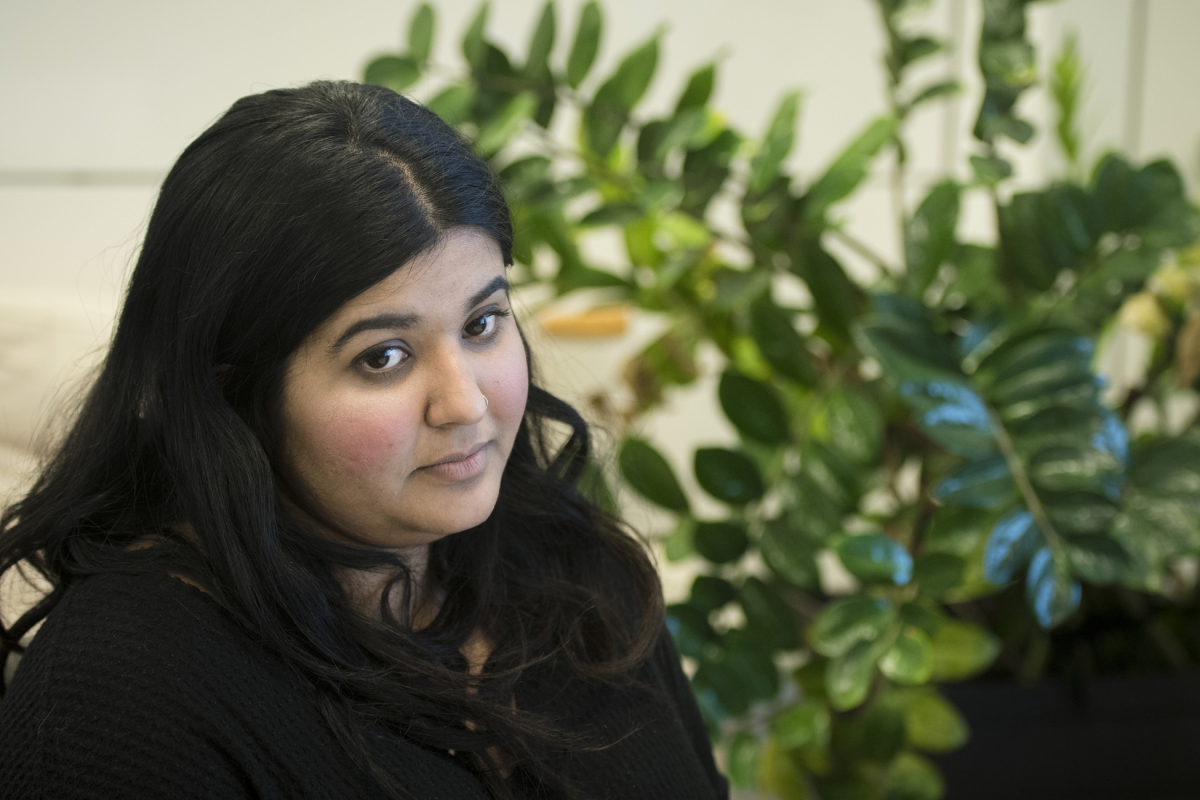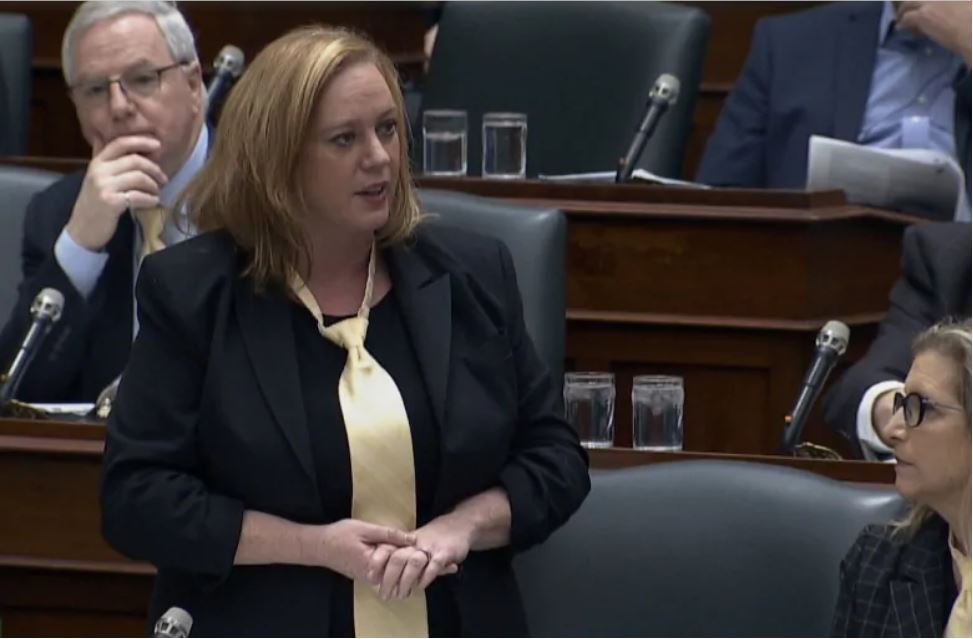Ontario child advocate wonders whether Doug Ford just made your children 'invisible again'

Editor's note: This article includes graphic details that some readers may find disturbing.
For 12 years, a framed program of Katelynn Sampson’s funeral has been sitting on Irwin Elman's desk.
The seven-year-old girl was discovered dead in a Toronto apartment in August 2008. There was blood in every room. A coroner found 70 wounds across her small, battered body. A pathologist found the damage to her liver from beatings akin to a car crash.
The little girl's two legal guardians, appointed by Ontario’s child welfare authorities, pled guilty to second-degree murder in May 2012.
Elman was appointed Ontario’s first independent provincial child and youth advocate a year before Sampson’s death. He attended her funeral. He called for a coroner’s inquest. He attended every official proceeding about her. He fought for more new investigative powers for his office to prevent any other child dying as Sampson did.
He urged then premier Kathleen Wynne to use the inquest jury's 173 recommendations as a template for change. Among them were proposed amendments to laws that would give children the right to be consulted directly on decisions affecting them, ranging from legal custody to which social worker to see at school.
The recommendations revealed the weakness of a child welfare system that was not putting youth first.
“Today, I hope Katelynn...becomes a turning point for our province,” he told reporters after the recommendations were made.
It was a turning point for him: he knew he had to work harder to protect vulnerable children across the province. From the start, Elman used his brand new position to create an office that advocates for neglected children across the province in care, in the youth justice system, in neglected Indigenous communities and in newcomer groups.
The Office of the Provincial Advocate for Children and Youth fielded over 21,000 calls last year seeking help for children in the welfare system. Over the years, Elman and his team have shed light on horrifying situations in foster and group homes ranging from lack of proper diet to physical abuse.
His work has attracted global attention for the way it has brought youth voices to the forefront. In April, a contingent of Japan’s youth public service was set to visit the office to learn how to replicate their operations and their model for youth support across the world.
The group is proceeding with their trip, but Elman will no longer be there when they arrive.
Friday, March 29, marked Elman’s last day as Ontario’s first and only independent child advocate.
The office is scheduled to shut down on May 1, one of three independent watchdogs eliminated with the stroke of a pen by Finance Minister Vic Fedeli's 2018 fall economic statement.
All three watchdogs — the commissioner of French language services, the environment commissioner and the child advocate — saw their unique roles terminated in a single paragraph of the economic update released by Premier Doug Ford's government.
Fedeli insisted the move would save money, reduce red tape and increase competitiveness in Ontario's economy.
The office of the child advocate spent $10.6 million in 2017, according to official numbers. But Fedeli has been unable to confirm if axing the position will save taxpayers money. Elman's responsibilities aren’t being eliminated; they’re being transferred, in part, to the provincial ombudsman.
The ombudsman is a neutral, independent officer who will not be taking the advocacy function, according to a spokesperson, but will continue to investigate all matters relating to child and youth services in Ontario.
When his office was suddenly abolished, Elman said he felt he had been “hit by a truck." The legislated closure date was April 1 but the ombudsman, Paul Dubé, needed more time to get ready and moved it to May 1.
Elman stayed to give the ombudsman his “best advice” and protect his staff as much as he could. A year ago, the advocate’s office finalized a procedure that would notify them of any deaths of children and youth in care. Elman wanted to make sure that procedure would carry on in the ombudsman's office.
It won't. The ombudsman will only be taking the child advocate's investigative abilities, and look into cases that are reported.
Technically, Elman is serving bonus time. He was scheduled to leave the office on Nov. 24, 2018. He told then newly-appointed Minister of Children Lisa MacLeod that she had to reappoint somebody. The two were friendly; she was on the hiring committee who appointed him. In November, she was reluctant to let him go, unsure the government could find anyone like him.
Elman recalled telling MacLeod that the point was to build on the work he had done, and "ask young people who they want.”
MacLeod has not communicated with him since that November meeting, and Elman has been stripped of his powers: he can't issue reports to counter the government’s autism funding cuts (which have recently been reversed); he can’t invest resources to show how children with special needs will be hurt by proposed larger class sizes that the government announced earlier this month and justified by saying it would make children more “resilient.”
“If I say anything, people might feel like it’s sour grapes,” he told National Observer in a March 26 interview. “Ironically, if I'm going to say anything, if I'm going to do anything, it's stronger to not to do it in this position at this point.”
“It's incredibly difficult to watch what's going on and be THIS child advocate,” he said, gesturing to his office, where boxes were waiting to be filled.
He hesitated momentarily, choosing his words carefully before he continued to speak. He said he felt some anger, but also that he wanted to appear hopeful to inspire his staff and the province's children.
He stopped speaking, appearing to be close to tears and forced a smile.
Elman has a couple of stuffed animals from Winnie the Pooh stories on the top shelf of his desk, Eeyore and Tigger. The staff gave it to him in the wake of Sampson’s case, because he was always sad like Eeyore. They reminded him he had to be like Tigger for the kids: optimistic.
“Everything that's been done seems to me to touch on children. I just don’t know what to say. When I'm not being hopeful for the young people, I cannot stop thinking how hard it will be if they become invisible again,” he said, his voice shaking. “That was the tip of the iceberg for me: nobody really realizes the number of children and youth connected in some way to child welfare care who die without our knowledge."
"All because we don't listen to them."
How Ontario's child advocate gave youth the 'right to express their own views freely and safely'
Elman knows he was “an unusual institutional choice” for the Ontario government to appoint as the first independent child advocate. He had once applied for a public service position in the youth ministry and made it through the entire hiring process, including a crucial critical thinking test. But they didn’t hire him; the ministry told him they didn’t think he’d “fit with the culture.”
“Which is true,” Elman exclaimed.
The 62-year-old teacher is a father of two young boys and a grassroots activist. For 25 years of his life, he served at a centre for young people who left the child welfare system in Toronto, aiming for a 100 per cent success rate in getting every student who passed through that centre a post-secondary education.
There was a child advocate position in the Ministry of Children for 30 years before the Liberal government decided to make it an independent watchdog position in 2007. Elman didn’t think much of it, he recalls, but one of the young people he had helped over the years called him and urged him to apply.
“I remember thinking that they would never hire me,” he said. “But this young person I had once helped called and asked me ‘what would you have said to us?’ You would have said ‘it’s not about whether you’ll get hired or not. It’s about whether you want to make a change or not.’”
MacLeod was on the hiring committee, he recalled. So was NDP leader Andrea Horwath.
The goal was to make sure that any reports, criticisms or investigations weren’t “cleansed” by the government in power, “because that’s what happens when they’re not independent,” Horwath said in an interview.
An independent watchdog would mean that children’s concerns could be brought forward with “forcefulness and vigor” without political interference. “No minister of children and youth services wants to have her or his ministry and the work that they're doing pilloried by an independent officer,” Horwath said.

When Horwath met Elman, she found that he had “what was necessary to actually develop the child advocate’s role into not just being reactive to the problems that exist in the child welfare system and the children and youth justice system but to start doing things to try to proactively make change."
The mandate of the 2007 Provincial Advocate for Children and Youth Act, which established the Elman’s position and office includes the following elements:
Provide an independent voice for children and youth, including First Nations children and those with special needs, by partnering with them to bring issues forward;
Encourage communication and understanding between children and their families and the people who provide them with services;
Educate children, youth and their caregivers regarding the rights of children and youth; and
Conduct investigations about matters concerning a child or group of children under the care of a Children’s Aid Society (CAS) or a residential licensee where the CAS is the placing agency and make recommendations.
Advocacy, as outlined in the Act, is defined as "promoting the views and preferences of children and youth." This means that advocates take instructions directly from the young person (unless they are deemed incapable).
As the jury on Sampson’s case recommended, the act also guarantees children and youth in care a “right to express their own views freely and safely … and to be informed, in language suitable to their understanding."
Guided by the principles of the United Nation Convention on the Rights of the Child, including the right to be heard, the law also asks the advocate’s office to be an "exemplar” of meaningful child and youth participation in every aspect of its work.
“We couldn’t be an exemplar,” Elman recalls telling the committee during his interview. “Nobody can ever achieve that because we all have our warts. But we would try. We would struggle to be an exemplar and we won’t stop struggling.”
Instead, his pitch to them was an extension of his centre: a space which gave young people control over their lives and the ability “to name their world.”
“That’s what humans do, right? They name the world they want,” he said. But the children services system at the time was not giving children in the province the ability to take reign over that right, Elman recalled, especially those who were in Indigenous and LGBTQ communities.
“I thought if we were an office that names the world for the young people of the province, we would be harming them,” he said. “I thought we needed to be progressive and liberating and give children the chance to name their worlds and when they did that, they could be allowed to be fully human.”
“They bought it, I guess,” Elman said matter-of-factly. One of the first congratulatory emails he got was from a frontline child and youth worker who wrote “I can’t believe one of us got the job.”
“I think people were expecting a lawyer or a bureaucrat or someone who was a senior executive somewhere to get the job. Not somebody who was physically as close to young people as I was,” he said.
“Somehow, It worked,” he added, shrugging his shoulders as if he still doesn’t believe it.

The bill passed unanimously at the time, and Elman was appointed easily.
“My party … is proud to have been the first to introduce the child advocate in Ontario, who was Les Horne, under the premiership of Bill Davis in 1984,” MacLeod, then just an MPP, told the legislature in 2007, speaking to the bill.
Her enthusiasm did not wane when she took on the child services portfolio in June 2018. “I’ve loved working with you for the past 10 years,” she tweeted at Elman in September. “I am excited to now be minister so we can bring in some long-awaited changes!”
Elman said that in one conversation he had with her, MacLeod used the phrase “fundamental change.” He just didn’t expect a removal of his office to be that change.
Elman said he has reached out to MacLeod a couple of times to ask for an explanation. “I just want to sit down. I don’t even want to argue. It’s over now, right? Just tell me what you’re thinking. I know you must have an idea. Why are you doing this?” He received a message from her chief of staff that said “this is not a good time,” according to Elman. So, he gave up.
Ontario's youth 'deserve so much better than what this government is doing to them'
Hope Kempe has worked as a child advocate in the Thunder Bay Office since November 2016, where advocates facilitated the Feathers of Hope forums, which brought young Indigenous people together from all over Ontario to meet, discuss issues of importance to them and push for change. No other government organization is doing on the ground work to build relationships with Indigenous youth in a city that is suffering a suicide crisis.
Each time Kempe visited a child the first thing she tells them is that they are completely in charge.
“I tell them that I don't take orders from adults. I don't take orders from the government. I don't take orders from anybody else, but them. They are the boss here. I'm here to work for them,” she told National Observer in an interview. “And it makes a huge difference. It makes a huge difference.”
Kempe cries on the phone when she recalls one little girl who asked her to attend a meeting to get her placement in an abusive foster care situation changed so she could be closer to her brother. The young girl was 12 years old when she had to make her case in front of four adults across the table.
“Whether you're asking to change a placement or you're asking for a new worker or you feel like your rights have been violated, as a young person to be facing a panel of adults on your own it's pretty intimidating,” Kempe said.
“I’m worried about kids like her, who have lost so much in this, who have been tossed aside and told by this government that they’re not important and they don’t matter,” she said. “These kids are stuck behind these barriers and and our office was part of that process of breaking those barriers down for them.
“These kids really they deserve so much better than what this government is doing to them,” Kempe added.
National Observer spoke to two mothers whose kids worked extensively with Kempe. Their kids cried when they learned they wouldn’t have access to their advocate anymore.
One, who asked to be anonymous as her foster daughter’s case was ongoing at the youth tribunal, recalled that Kempe knew exactly how to talk to her daughter and son, who both have disabilities. Kempe took her kids outside on the family farm near their animals and made an effort to ask the children short and simple questions to ensure that they understood what was being asked.
“Without (Kempe), my kids would still be neglected,” the Thunder Bay-based mother recalled.
The problem, Elman said, was that the bar for his office was low because “so little was expected or thought” of the young people in his office’s mandate. Over his career, time and again, he has heard feedback that the kids his office interacts with are “so articulate,” so “brave and courageous,” or “they have overcome so much” or “they’re so special.” Elman’s least favourite was “it's so refreshing to hear from young people.”
“It’s all crap,” Elman said. As long as the governance system keeps making decisions about youth without their input, they will never get it right, he said.
“When kids name their world, they’re not saying anything that people don’t already know,” he said. “When young people say the child welfare system is messed up and this is how it's hurting us, do you think ministers and social workers don’t already know that already?”
"It's not hard to get young people to talk; you just have to genuinely ask them and be interested and listen. You don’t even have to agree. The worry is to get young people to hope that them saying something makes a difference," he said.
The problem is that our governance systems and institutions have a "silencing quality," Elman said. There is certainly no shortage of problems to address: the advocate’s first “serious occurrences report,” which compiled data from mandatory reporting, found 19 children in or recently in state care had died in just the first three months of 2014. Of the two suicides, one was on a wait list for mental health care. During that period there were 334 serious injuries, 123 of them self-inflicted, including 48 instances of cutting. There were 944 young people reported missing, of which 258 had not been found at the end of the reporting period. There were 206 reported mental health crises.
The office was attracting attention around the world not just in the way it was handling these issues, but in the fact that young people were actively involved in advisory committees, advocacy, office design and so forth. Elman set the precedent: every decision, policy recommendation, or action had to be substantiated by an explanation as to how young people were involved. If young people weren’t involved, staff would have to explain why.
It took some work. Elman and his staff had to persuade people that engaging young people wasn’t a revolutionary idea; it was just common sense.
“Six-year-old children have voices too, but we didn’t know how to get them heard in our mandate,” said Ashley Ash, 22, who had a contract position at the child advocate's office in 2018, but had known it existed as a child in care for 12 years of her life.
These were “non-institutional ideas,” Elman said, and they were hard to do. Countless times, the legislature questioned his decisions and said that’s not the way things are done. They didn’t have honorariums for youth. Young people don’t speak in committee. Young people don’t gather.
“It was a magical mess,” he said.

Their “watershed” moment came in 2011 when hundreds of Ontario’s youth gathered at Queen’s Park to make their voices heard on amendments to the Child Youth Family Services Act — the first time the act had been amended in two decades. Part of the proposed 200 amendments was the residential review placement system, which allowed young people to request changes in where they were placed. The government proposed to give power to the social worker, service provider and parents, noting that young people would merely be informed of the decision.
Ash helped organize students to come to the committee hearing for the omnibus bill, which was announced only a day before. “You can actually influence legislation about your life,” she recalled telling her peers. “It would be ridiculous if young people didn't have a say in that because this bill governs over young people's lives."
The gathered youth at Queen’s Park agreed, and demanded the clause about residential review placement be amended to say young people must be informed “in a way they can understand.”
“I loved that because it puts the onus on the system,” Elman said. “It's not just 'we’ll decide and you’ll understand.' It’s that 'we must explain it to you and learn how to explain it to you in a way you can understand.'”
That day, the minister testified before their young people, answered their difficult questions. They told the minister that the province was their guardian, their parents, and they need to talk to them.
“They just kept pushing and pushing and nothing was ever done like that before,” Elman recalled smiling. Ash, 19 at the time, recalled that Elman was allocated 30 minutes of speaking time at the committee hearing and gave up 15 minutes to three young people, including herself. Sitting in front of a room of policymakers and stakeholders was "intimidating," but she felt she "had every right to be there as much as Irwin did, as much as the adults did.”
“You can only fix things in partnership,” Elman said, smiling proudly at Ash in his office. “And that’s where I thought we were when our office was closed. I thought we had helped influence our office to get to a point where we were actually in partnership with young people. We could fix something.”
“Including their voices was a human solution. It has to be part of the culture of the systems of care, whether its mental health or child welfare justice,” he said. “We were just on the precipice of doing that.”

Without the child advocate 'who are they going to call?'
On the day the child advocate’s office was axed, Children Minister Lisa MacLeod stood in the legislature and promised to be “the fiercest child advocate in this province.”
“She's not going to be able to do that,” Kempe said. “She's not going to be able to go and meet with these individual kids and attend meetings with them or attend meetings on their behalf. She's not going to be able to do that. And that's what we do.”
Two mothers told National Observer it was “impossible” for MacLeod to take care of every child in the province. The result, they both said, is “children are going to die.” There will be more Katelynn Sampsons, they say. And there will be no Irwin Elman to demand an inquest and accountability, they said.
In response to questions about the decision to shut down the office, MacLeod sent National Observer a statement saying that the Ford government was “strengthening the authority and investigative services to include oversight of children and youth in care in the ombudsman’s mandate." She also said her ministry will review all the work by the child advocate to make sure “no child falls through the cracks.” She added that the ministry will also create three new advocacy roundtables made-up of the “lived experience in the fields of Indigenous child welfare, children-in-case, and youth-in-custody.”
“In addition, I am embedding a child advocacy function within my ministry. This work is currently underway and I look forward to sharing more on this,” she wrote.

A spokesperson for the ombudsman’s office said they will “continue to take calls and complaints from children and youth and address them as we do all matters within our mandate: Our staff will listen, provide information and referrals (including about young people’s rights and options), track complaint trends to identify problems or systemic issues.
Kempe does not believe the new structure is in favour of the children in the province. "The ombudsman will take complaints, but we take and respond to complaints. We go to to them one by one," she said. "It's individual advocacy that the office offers, so it's not simply taking a phone call and taking their complaint and referring them somewhere else." Kempe added that she has been working with kids for two years or more. They have her number and just call whenever there is a problem.
One investigator from the child advocate's office, who spoke to National Observer on the condition of anonymity so as to not harm his employment opportunities, said that under the current mandate, child advocate investigators did individual and systematic investigations. The province-wide bigger picture issues, like the use of physical restraint of young people living in group homes, will be lost in the ombudsman's office because he has limited resources and many issues to look into.
The child advocate’s office gave the province “an understanding of the young population in Ontario that I don’t feel any other organization or agency has ever done,” Ash said. "It felt like there was accountability and there was a place to call or somebody who would actually listen to what you were saying here at do something about it.”
These are the kids that no longer have faith in the system, Kempe said. "We were the only steady thing in their lives. And now we're gone. Now, who is going to listen to them, care for them? Who are they going to call?"
Over the years the child advocate’s office has spent time and resources and money on employment programs and studies and policy documents and social housing. But, Elman said when he spoke to young people about why the Child Advocate’s office matters they say its because they can call them anytime any place. Advocates give them their home numbers so they can phone them when we need it. They may not use it much but they have it.
"It's hard to be hopeful to be honest," said one member of the child advocate team in Toronto, who wished to stay anonymous. "The services that most immediately impact a young person in their day-to-day experience is their advocacy function. Unless these children are going to call Lisa MacLeod and she’s going to hop on a bus and go to Thunder Bay, for example, they're just not going to have anyone to call."
“That’s the big, heartbreaking secret,” Elman said. “You know, governments ask me what I want them to do? All I want to say to them is that we can’t legislate love. But you can legislate the conditions in which love can flourish”
“How hard is it to do that?"
Editor's note: This story was corrected at 12:30 p.m. to accurately state that the three new child advocacy roundtables are being set up by the Ministry of Children and not the ombudsman. We regret the error.






Comments
Our children deserve our best efforts....
It is heartbreaking for Ontario to lose their children's advocate. Vulnerable children are not the place to make cutbacks! Prevention services are ALWAYS cheaper than crisis services. Nothing good will come of this.
Difficult to read this article. A heartbreaker. Why would the Ontario government do this. The $$ are so tiny in relation to the budget. I hope, however, that this move will prove positive for kids. But I doubt it.